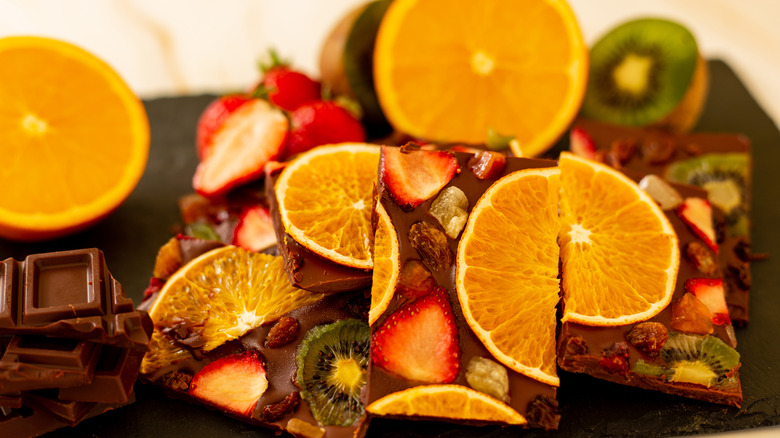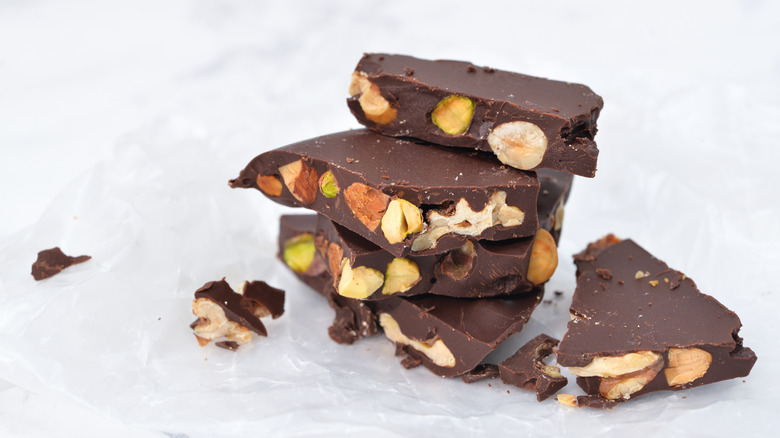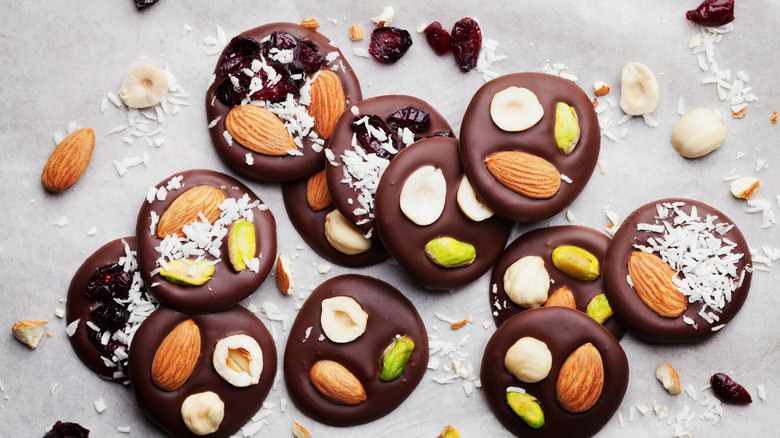The Decorative Difference Between French And American Chocolate Bark
Whether you prefer it as a Christmas delight or a decadent dessert for any time of year, chocolate bark is wonderfully sweet, simple, and customizable. The distinctive snap, crunchy mix-ins, and flavorful toppings make chocolate bark a magnificent member of the chocolate family. From the holiday favorite peppermint white chocolate bark or the rich sea salt dark chocolate and almond bark to the visually stunning layered chocolate bark, this is a simple and scrumptious dessert guaranteed to please at parties.
However, the French version of this sweet culmination of mix-ins looks a little different than its American counterpart. Generally speaking, European and American chocolate differs in several ways: cacao percentage, sugar content, amounts of fat, cocoa bean origins, and mix-in ingredients. Aside from the differences in taste and texture, French chocolate bark has its origins in the French mendiant, a chocolate treat with decorative, flavorful toppings. American chocolate bark recipes often call for mixing the added ingredients into the melted chocolate, masking the mix-ins rather than boldly displaying them on top.
American chocolate bark
Known for favoring all things sugary, Americans adore an extra sweet version of chocolate. American chocolates tend to have a lower cacao percentage, more sugar, and boast fillings like nuts, caramel, and flavored creams. Because Americans already prefer the sweetness of milk chocolate for chocolate bark, you should avoid adding oil or shortening to American chocolate bark so that it retains a hard consistency.
The American method results in crunchy chocolate bark with fun surprises inside, perfect for cracking or snapping into pieces. For this type of chocolate bark, melt your desired chocolate variety (white, semisweet, dark, milk, etc.) in a large bowl, then stir in your chosen additions. Fully coat the mix-ins with the chocolate, then pour out the combined mixture and allow it to cool. Once the chocolate bark is fully hardened, you can enjoy a lusciously layered snack reminiscent of the American-invented peanut brittle.
French chocolate bark
Europeans account for about half of the world's chocolate consumption, so it's no surprise that French chocolate bark is especially delicious. European chocolates rely less on sweeteners, instead embracing the flavor resulting from cacao. Notably, European chocolate also features a greater variety of ingredients, adding fruit, herbs, and ganaches to the mix.
Unlike American chocolate bark, French chocolate bark originated from an old French candy: mendiants. Beginning as a Roman Catholic monastic-inspired treat, mendiants are little discs of melted chocolate peppered with tasty ingredients like nuts and fruit. The visually striking toppings, like orange peels, candied apricots, rose petals, pistachios, and cranberries, make French chocolate bark stand out in the candy world. To create this effect, simply pour your melted chocolate, wait for it to firm just a bit, then gently sprinkle toppings onto the chocolate so that they stick. You'll not only have a beautiful dessert but one with exciting flavor combinations.


